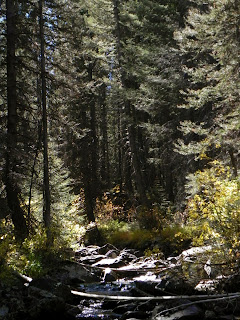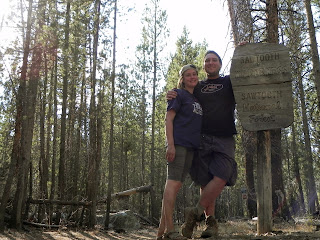We spent some time in Rocky Mountain National Park before heading to Denver (where we are currently staying for a few days – in a hotel!) Our first day, we headed out with backpacks to Lawn Lake – staying in campsite halfway between the trailhead and the lake.
(There is a rainbow in this picture – although, it’s a little hard to see.) It was a cold and rainy afternoon (and it looked like it was snowing in the direction of the lake) so we decided to just relax that afternoon and head out to the lake in the morning.
We were exploring around the creek beside the campsite – and Graham likes to cross what he calls “river ladders” where there are rocks that you can hop across. I always get nervous that I’m going to fall in, which I did do on this particular afternoon. My soaking wet shoes put an early end to the adventure.
The cold wore us out and we went to bed around 4 in the afternoon – not to wake up again until 10 in the morning. I can understand why bears have evolved to hibernate in the winter – it was pretty awesome.
In the morning, after eating our dinner that we slept through, we headed up the lake on a beautiful, sunny day. About a mile or so from the lake, we started to see a light dusting of snow that had probably fallen the day before.
It was a beautiful lake located right at the tree line. It was extremely windy and chilly – but I could have sat there all afternoon enjoying the beauty around us. We headed back down the mountain following the stream that flowed out of the lake.
We grilled steaks and mushrooms over the campfire for dinner. In the morning, everything (including our shoes) was covered in about two inches of snow. So instead of hiking, we drove around and just enjoyed the park.
I went camping earlier this year at Wolf Lake in Yellowstone. We were lazy and napped out in a field for most of the morning after a storm had kept us the better part of the evening. A coyote had wandered to the field and got about 20 feet away from us. He was curious about the area – it was awesome to see one so close.
I have an irrational fear of coyotes because when I was a little kid my dad told me that if I was out after dark a coyote could eat me. However, after seeing them in the wild (always just a lone coyote), I see how beautiful they are – just doing there best to survive in a world so altered by humans.
(Later that night, we went to dinner because it was cold and we wanted to sit inside. On our way back to our campsite, we saw a cat of some kind – maybe a Lynx or a Bobcat – run across the road!)
The next day (after our shoes had dried out), we went for a loop hike that passed by four different mountain lakes – Nymph Lake, Dream Lake, Emerald Lake and Lake Haiyaha.
This is a Steller’s Jay. The day before, we had walked about a mile around Bear Lake. There had been two Steller’s Jays that we chased partially around trying to take their picture. On our way down from the lakes, we passed Alberta Falls where a family was picnicking. There were two Steller’s Jays that were sitting on a rock by the screaming kids. (Don’t feed the wildlife.)
We are in Denver, CO staying at a Hyatt in downtown right now. Graham is working at an expo thing for his mom – and I’m just relaxing and taking as many showers as I can.

















































